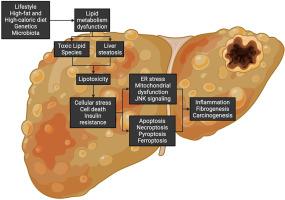Lipotoxicity-driven metabolic dysfunction-associated steatotic liver disease (MASLD)
IF 5.7
2区 医学
Q1 CARDIAC & CARDIOVASCULAR SYSTEMS
引用次数: 0
Abstract
Metabolic dysfunction-associated steatotic liver disease (MASLD) encompasses a spectrum of liver lesions, ranging from simple steatosis to metabolic dysfunction-associated steatohepatitis (MASH), that may further progress to cirrhosis. MASLD is estimated to affect more than one third of the general population and it represents a risk factor for end-stage liver failure and liver cancer, substantially contributing to liver-related morbidity and mortality. Although the pathogenesis of MASLD is incompletely understood, it is known to consist of a multifactorial process influenced by extrinsic and intrinsic factors such as metabolic, environmental and demographic features, gut microbiota and genetics. Dysregulation of both extracellular and intracellular lipid composition is known to promote the generation of toxic lipid species, thereby triggering lipotoxicity and cellular stress. These events ultimately lead to the activation of distinct cell death pathways, resulting in inflammation, fibrogenesis and, eventually, carcinogenesis. In this manuscript, we provide a comprehensive review of the role of lipotoxicity during MASLD pathogenesis, discussing the most relevant lipid species and related molecular mechanisms, summarizing the cell type-specific effects and highlighting the most promising putative therapeutic strategies for modulating lipotoxicity and lipid metabolism in MASLD.

脂肪毒性驱动的代谢功能障碍相关性脂肪性肝病(MASLD)
代谢功能障碍相关性脂肪性肝病(MASLD)包括一系列肝脏病变,从单纯性脂肪变性到代谢功能障碍相关性脂肪性肝炎(MASH),并可能进一步发展为肝硬化。据估计,超过三分之一的普通人群患有 MASLD,它是终末期肝衰竭和肝癌的危险因素,大大增加了与肝脏相关的发病率和死亡率。虽然人们对 MASLD 的发病机制尚不完全清楚,但已知它是一个多因素过程,受到代谢、环境和人口特征、肠道微生物群和遗传等外在和内在因素的影响。众所周知,细胞外和细胞内脂质组成的失调会促进有毒脂质的生成,从而引发脂毒性和细胞压力。这些事件最终会导致不同的细胞死亡途径被激活,从而引发炎症、纤维化并最终导致癌变。在本手稿中,我们全面综述了脂毒性在 MASLD 发病过程中的作用,讨论了最相关的脂质种类和相关分子机制,总结了细胞类型特异性效应,并重点介绍了在 MASLD 中调节脂毒性和脂质代谢的最有前景的假定治疗策略。
本文章由计算机程序翻译,如有差异,请以英文原文为准。
求助全文
约1分钟内获得全文
求助全文
来源期刊

Atherosclerosis
医学-外周血管病
CiteScore
9.80
自引率
3.80%
发文量
1269
审稿时长
36 days
期刊介绍:
Atherosclerosis has an open access mirror journal Atherosclerosis: X, sharing the same aims and scope, editorial team, submission system and rigorous peer review.
Atherosclerosis brings together, from all sources, papers concerned with investigation on atherosclerosis, its risk factors and clinical manifestations. Atherosclerosis covers basic and translational, clinical and population research approaches to arterial and vascular biology and disease, as well as their risk factors including: disturbances of lipid and lipoprotein metabolism, diabetes and hypertension, thrombosis, and inflammation. The Editors are interested in original or review papers dealing with the pathogenesis, environmental, genetic and epigenetic basis, diagnosis or treatment of atherosclerosis and related diseases as well as their risk factors.
 求助内容:
求助内容: 应助结果提醒方式:
应助结果提醒方式:


